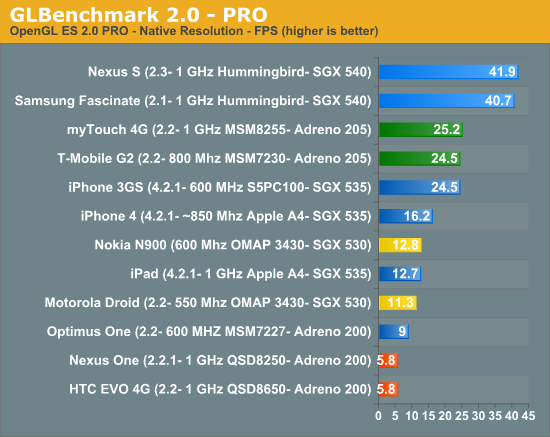GLBenchmark 2.0 Released - Modern SoCs Benchmarked
by Brian Klug on December 17, 2010 2:08 AM EST- Posted in
- Smartphones
- GLBenchmark
- Mobile
- SoCs
We're constantly on the lookout for new benchmarks to use for benchmarking the latest SoCs in devices. Today, Kishonti Informatics released GLBenchmark 2.0, the latest version of its popular GLBenchmark suite for measuring 3D graphics performance across a host of platforms: iOS, Android, Symbian, Windows Mobile, and Maemo. We've been testing it out for a while now and have some numbers of our own and from the community results. The end result is yet another look at how 3D performance stacks up between nearly all modern SoCs.
GLBenchmark 2.0 - as its name implies - tests OpenGL ES 2.0 performance on compatible devices. The suite includes two long benchmarking scenarios with a demanding combination of OpenGL ES 2.0 effects, and individual tests such as swap buffer speed (for determining the framerate cap), texture fill, triangle, and geometric tests. GLBenchmark 2.0 also leverages texture based and direct lighting, bump, environment, and radiance mapping, soft shadows, vertex shader based skinning, level of detail support, multi-pass deferred rendering, noise textures, and ETC1 texture compression.
We've been testing devices for a little while now and have a decent enough spread to make for some interesting comparison. The only extra consideration is that all of these were run at the device's respective native resolution. There's no way to change resolution, and likewise numbers cannot be scaled linearly because we may be memory bandwidth limited on some devices. GLBenchmark will join our benchmark suite for devices going forward.
First are the resolutions (native) of the devices themselves:
| Device Resolutions - GLBenchmark Native Resolution | |||||
| Google Nexus One | 800x480 WVGA | ||||
| LG Optimus One | 320x480 HVGA | ||||
| T-Mobile myTouch 4G | 800x480 WVGA | ||||
| Samsung Fascinate | 800x480 WVGA | ||||
| Google Nexus S | 800x480 WVGA | ||||
| HTC EVO 4G | 800x480 WVGA | ||||
| Apple iPhone 4 | 960x640 DVGA | ||||
| Apple iPad | 1024x768 XGA | ||||
| Motorola Droid | 854x480 FWVGA | ||||
| T-Mobile G2 | 800x480 WVGA | ||||
| Nokia N900 | 800x480 WVGA | ||||
| Apple iPhone 3GS | 320x480 HVGA | ||||
Thankfully, comparison across devices running Android is easy thanks to the relatively standard WVGA resolution guidelines for high end devices.


The first benchmark, Egypt, tests OpenGL ES 2.0 and represents the newest and most demanding benchmark. The second - GLBenchmark PRO - represents a suite that tests OpenGL ES 1.1 performance. (edit: GLBenchmark Pro also tests OpenGL ES 2.0 features, and is a port of an earlier GLBenchmark 1.1 test which focused on OpenGL ES 1.1 performance). Moving forward we will report these whenever possible on smartphone reviews.
It's pretty apparent right now that PowerVR SGX 540 still holds the lead, though the new 45 nm Qualcomms with Adreno 205 are a huge jump forwards from Adreno 200 performance wise. It's interesting that it looks like we're GPU or memory bandwidth bound on those new Qualcomms, as evidenced by the similar results the myTouch 4G and G2 post despite a 200 MHz CPU clock disparity.
Overall, GLBenchmark is designed to showcase some of the OpenGL ES 2.0 features that developers may potentially use in future gaming titles. There are a lot more low level tests which we'll be playing around with in the future and using to test in much more detail.

















64 Comments
View All Comments
Devo2007 - Saturday, December 18, 2010 - link
I saw these same issues on my Galaxy S (Froyo). so it's possible that is the phone they grabbed the screenshots from.overzealot - Saturday, December 18, 2010 - link
Have you ever seen a rendering with damaged memory before?That video is nothing like it. Nothing AT ALL.
LordSojar - Friday, December 17, 2010 - link
Why no Tegra2 benchmarks? LG's Optimus 2X utilizes it, as does an upcoming phone from Motorola. And that's excluding the tablets that current are or soon will be using it: Viewsonic G, RIM Playbook, Notion Ink ADAM, Samsung's Galaxy S-2 Tab, and Motorola's tablet that was shown running Honeycomb.So.. why no Tegra2 results. We already know it will likely slaughter everything, but I'd like to know by how much.
A5 - Friday, December 17, 2010 - link
They have to have hardware to test, and as far as I know they haven't reviewed any Tegra 2 hardware.Roland00Address - Friday, December 17, 2010 - link
They do have a tablet running Tegra2 hardware. It is the viewsonic g1 tablet running Tegra2 and 1024x600We got a first look here
http://www.anandtech.com/show/4054/first-look-view...
Currently they are getting it ready for a review. Sadly the software it comes with stinks so they have to root it to make it useful.
srench - Friday, December 17, 2010 - link
lordSojar wrote: "So.. why no Tegra2 results. We already know it will likely slaughter everything, but I'd like to know by how much."You should wait for the hardware and benchmarks before calling the result. Nvidia have very little experience in low power SoC.
Most of the players listed are well into next gen graphics chips. I expect the later versions of SGX will appear in ipad2 and possibly MP versions.
Nvidia would have to beat these results by miles just to stay relevant in this space.
re ipad results - too many comments are not taking into account screen size!
DeathReborn - Friday, December 17, 2010 - link
Although not benched by me these are the scores for the Malata Zpad (Tegra 2 tablet)1024x600 Res:
Egypt - 19.9 fps
Pro - 41.4 fps
For Comaprison the Galaxy Tab gets this:
Egypt - 15.9 fps
Pro - 30.9 fps
About Hummingbird SGX540 performance with a higher resolution. Performance of Tegra 2 may increase with a Dual Core configured OS (Malata Zpad isn't running one).
epol - Friday, December 17, 2010 - link
If you are looking to add a Droid 2 to the mix, use the Droid 2 Global. This is what will be replacing the Droid 2 and it runs at 1.2 ghz. Right now they're both being sold but Moto's plan is to let the Droid 2 Global replace the Droid 2 as stock sells out.zhill - Friday, December 17, 2010 - link
The disparity in actual performance between the iPhone 3GS and iPhone 4/iPad is exactly why I'm very skeptical of a *major* upgrade to the display in the next iPad. Anything approaching "Retina" resolutions (300dpi) would mean the panel would far exceed 1080p and there is no way that the current-gen or even next-gen SoCs could push enough pixels for playable framerates at that resolution--probably not even Tegra2. If 1024x768 is 0.7MP and 132ppi then to get even to 200ppi you'd need something at least 1550x1162 (more realistically it would be either 1400x1050 and approx 180ppi or 1600x1200 and 206ppi) while a full 300ppi is a ridiculous 2325x1743--almost the same number of pixels as a 30" lcd monitor! So for the sake of argument, let's say they go with 1600x1200 to give the iPad a nice 206ppi. That is a 1.92MP display and a 144% increase in pixel count! I haven't seen any verifiable performance tests of Tegra2 and current SoCs, but there is a chance that nvidia's silicon could be up to the task; however, that would mean Apple would have to abandon their own silicon, which I don't see happening. Battery life would also most likely be abysmal, and the cost of such a large high-res screen would make it infeasible. Hence, I don't think we'll see any major upgrades to the iPad screen any time soon and these benchmarks show why.overzealot - Saturday, December 18, 2010 - link
Unless they decide to run a discrete GPU. It'd have to be pretty light though.